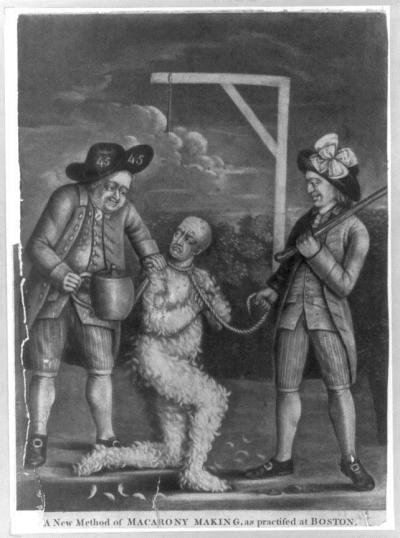Lesson Plan
Created by Kirstie Mahas
Notes by Betsy Hedler, Ohio History Connection

Core Theme:
Creating the Nation: The Revolution & Constitutional Development
Grade Level:
7/8
Estimated Duration of Lesson:
2 class periods (50 minutes)
Standards & Indicators:
Study Skills and Methods #2: Use primary and secondary sources to answer questions.
History #3: Identify and explain the sources of conflict which led to the American Revolution, with emphasis on the perspectives of the Patriots, Loyalists, neutral colonists and the British.
Primary Source Used:
File
Source: British Cartoon Prints Collection. Library of Congress Prints and Photographs Division Washington, D.C.
Image Numbers:LC-USZ62-45386 & LC-USZC4-14078
Lesson Summary:
After analyzing the Tarring and Feathering Prints, students will compare and contrast the prints using a Venn diagram.
Instructional Steps to Implement the Lesson:
- Students will then work with a partner to analyze one of the two prints. The pairs will use the Image Analysis Worksheet to discuss the print with each other.
- After analyzing the print and completing the analysis worksheet with their partner, the students will share their findings with the whole class. Students will list their observations under the print they analyzed on the board or smartboard.
- After listing the partner observations, the students will work in small groups to complete a Venn diagram comparing and contrasting the two prints.
- The students will share similarities and differences that were identified in the two prints.
- These responses will be used to compile the class’s Venn diagram for the two prints on the board or a Smartboard. As responses are shared, students will correct and add to their personal Venn diagrams.
- After discussing the similarities and differences between the two prints, students will write a paragraph response to the following prompt:
Today our Constitution protects us from cruel and unusual punishment in the Bill of Rights. Do you think the colonists would have considered tarring and feathering cruel and unusual punishment? Why or why not? (You should respond as a colonist from the 1700’s not a middle school student today!)
Post-Assessment and Scoring Guideline:
Students will write a paragraph response to the prompt. Each paragraph response will be evaluated for content as well as complete sentences. The response will be worth 10 points total.
Materials Needed by Teacher:
2) Venn diagram
Materials Needed by Students:
1) copy of Tarring and Feathering Prints
Extended Learning:
Students will discuss responses to cruel and unusual punishment prompt.
Note on prints for teachers:
Tarring and Feathering Prints Description:
These two prints show the Revolutionary practice of tarring and feathering royal officials and others whom the Sons of Liberty felt deserved punishment.
The first print shows two men with a tarred and feathered customs officer, they are forcing him to drink from a large teapot. The man has a short piece of rope around his neck which may have been attached to the piece of rope hanging from a gibbet in the background. On January 27, 1774, a British customs officer, John Malcolm, was tarred and feathered, led to a gallows, and forced to drink tea. The American holding the teapot wears a hat with "45" on it, a patriotic symbol referring to the John Wilkes case of 1763. The other American, holds the broken end of the noose and carries a club. The large bow in his hat indicates his membership in the Sons of Liberty.
The second print shows five men forcing a tarred and feathered customs officer to drink from a teapot, a bucket and a liberty cap are on the ground at his feet. They stand beneath the "Liberty Tree" from which a rope with a noose hangs; in the background, shadowy figures on a ship dump tea overboard.
